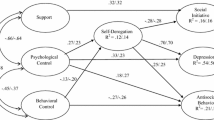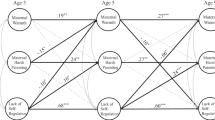Abstract
The purpose of the current investigation was to examine relations among maternal regulatory support, maternal antagonism, and mother–son relationship quality in relation to boys’ self-regulation during early adolescence. As part of a larger longitudinal study on 263 low-income, ethnically diverse boys, multiple informants and methods were used to examine associations among parenting practices and mother–son relationship quality in relation to boys’ self-regulation at ages 10 and 11. Multivariate analyses indicated that high levels of regulatory supportive parenting and relationship quality and low levels of antagonistic parenting independently predicted high levels of boys’ self-regulation at age 10. Only antagonistic parenting and relationship quality explained variance in levels of boys’ self-regulation at age 11 after accounting for prior self-regulation. The findings suggest that parenting and the context of the parent–child relationship are linked to self-regulation during early adolescence; however, it appears that parental antagonism and relationship quality, not maternal regulatory supportive parenting, contribute to rank-order change in self-regulation abilities. Implications of these results for research and practice are discussed.
Similar content being viewed by others
References
Barber, B. K., & Harmon, E. L. (2001). Violating the self: Parental psychological control of children and adolescents. In B. K. Barber (Ed.), Intrusive parenting: How psychological control affects children and adolescence (pp. 15–52). Washington, DC: American Psychological Association.
Baumrind, D. (1991). The influence of parenting style on adolescent competence and substance use. Journal of Early Adolescence, 11, 56–95.
Bedford, V. H., & Volling, B. L. (2004). A dynamic ecological systems perspective on emotion regulation development within the sibling relationship context. In F. R. Lang & K. L. Fingerman (Eds.), Growing together: Personal relationships across the lifespan (pp. 76–102). New York: Cambridge University Press.
Brody, G. H., & Ge, X. (2001). Linking parenting processes and self-regulation to psychological functioning and alcohol use during adolescence. Journal of Family Psychology, 15, 82–94.
Brody, G. H., Murry, V. M., McNair, L., Chen, Y., Gibbons, F. X., Gerrard, M., et al. (2005). Linking changes in parenting to parent-child relationship quality and youth self-control: The strong African American families program. Journal of Research on Adolescence, 15, 47–69.
Burt, S. A., McGue, M., Krueger, R. F., & Iacono, W. G. (2005). How are parent–child conflict and childhood externalizing symptoms related over time? Results from a genetically informative cross-lagged study. Development and Psychopathology, 17, 145–165.
Bynum, M. S., & Brody, G. H. (2005). Coping behaviors, parenting, and perceptions of children’s internalizing and externalizing problems in rural African American mothers. Family Relations, 54, 58–71.
Capelli, C. A., Nakagawa, N., & Madden, C. (1990). How children understand sarcasm: The role of context and intonation. Child Development, 61, 1824–1841.
Colman, R. A., Hardy, S. A., Albert, M., Raffaelli, M., & Crockett, L. (2006). Early predictors of self-regulation in middle childhood. Infant and Child Development, 15, 421–437.
Coplan, R. J., Hastings, P. D., Lagacé-Séguin, D. G., & Moulton, C. E. (2002). Authoritative and authoritarian mothers’ parenting goals, attributions, and emotions across different childrearing contexts. Parenting: Science and Practice, 2, 1–26.
Criss, M., & Shaw, D. S. (2003). Parent–child synchrony and antisocial behavior in middle childhood. Social Development, 12, 379–400.
Criss, M., Shaw, D. S., & Ingoldsby, E. M. (2003). Mother–son positive synchrony in middle childhood: Relation to antisocial behavior. Social Development, 12, 379–400.
d’Acremont, M., & Van der Linden, M. (2007). How is impulsivity related to depression in adolescence? Evidence from a French validation of the cognitive emotion regulation questionnaire. Journal of Adolescence, 30, 271–282.
Daniels, D., Dunn, J., Furstenberg, F. F., & Plomin, R. (1985). Environmental differences within the family and adjustment differences within pairs of adolescent siblings. Child Development, 56, 764–774.
Davidov, M., & Grusec, J. E. (2006). Untangling the links of parental responsiveness to distress and warmth to child outcomes. Child Development, 77, 44–58.
Denissen, J. A., van Aken, M. A. G., & Dubas, J. S. (2009). It takes two to tango: How parents’ and adolescents’ personalities link to the quality of their mutual relationship. Developmental Psychology, 45, 928–941.
Dennis, T. (2006). Emotional self-regulation in preschoolers: The interplay of child approach reactivity, parenting, and control capacities. Developmental Psychology, 42, 84–97.
Finkenauer, C., Engels, R. C. M. E., & Baumeister, R. F. (2005). Parenting behavior and adolescent behavioural and emotional problems: The role of self-control. International Journal of Behavioral Development, 29, 58–69.
Furman, W., & Buhrmester, D. (1992). Age and sex differences in perceptions of networks of personal relationships. Child Development, 63, 103–115.
Gestsdottir, S., & Lerner, R. M. (2008). Positive development in adolescence: The development and role of intentional self-regulation. Human Development, 51, 202–224.
Gresham, F. M., & Elliott, S. N. (1990). Social skills rating system manual. Circle Pines: American Guidance Service.
Grusec, J. E., & Goodnow, J. J. (1994). Impact of parental discipline methods on the child’s internalization of values: A reconceptualization of current points of view. Developmental Psychology, 30, 4–19.
Hetherington, E. M., Clingempeel, W. G., Anderson, E. R., Deal, J. E., Stanley Hagan, M., Hollier, A. E., et al. (1992). Coping with marital transitions: A family systems perspective. Monographs of the Society for Research in Child Development, 57, Nos. 12-3, 227.
Ingoldsby, E., Shaw, D. S., & Garcia, M. (2001). Intra-familial conflict in relation to boys’ adjustment at school. Development and Psychopathology, 13, 35–52.
Jones, E. E., & Gerard, H. B. (1967). Foundations of social psychology. New York: Wiley.
Kobak, R. R., Cole, H. E., Ferenz-Gillies, R., Fleming, W. S., & Gamble, W. (1993). Attachment and emotion regulation during mother-teen problem solving: A control theory analysis. Child Development, 64, 231–245.
Kochanska, G., & Aksan, N. (1995). Mother–child mutually positive affect, the quality of child compliance to requests and prohibitions, and maternal control as correlates of early internalization. Child Development, 66, 236–254.
Kochanska, G., Murray, K. T., & Harlan, E. T. (2000). Effortful control in early childhood: Continuity and change, antecedents, and implications for social development. Developmental Psychology, 36, 220–232.
Laible, D., & Thompson, R. A. (2007). Early socialization: A relationship perspective. In J. E. Grusec & P. D. Hastings (Eds.), Handbook of socialization: Theory and research (pp. 181–207). New York: Guilford.
Lengua, L. J. (2006). Growth in temperament and parenting as predictors of adjustment during children’s transition to adolescence. Developmental Psychology, 42, 819–832.
Loukas, A., & Roalson, L. A. (2006). Family environment, effortful control, and adjustment among European American and Latino early adolescents. Journal of Early Adolescence, 26, 432–455.
Martin, J. (1981). A longitudinal study of the consequences of early mother–infant interaction: A microanalytic approach. Monographs of the Society for Research in Child Development, 46.
McCarthy, C. J., Lambert, R. G., & Seraphine, A. E. (2004). Adaptive family functioning and emotion regulation capacities as predictors of college students’ appraisals and emotion valence following conflict with their parents. Cognition & Emotion, 18, 97–124.
McCartney, K., Burchinal, M. R., & Bub, K. L. (2006). Best practices in quantitative methods for developmentalists. Monographs of the Society for Research in Child Development, 71(3, Serial No. 285).
Melby, J. N., & Conger, R. D. (2001). The Iowa family interaction rating scales: Instrument summary. In P. K. Kerig & K. M. Lindahl (Eds.), Family observational coding systems: Resources for systemic research (pp. 33–58). Mahwah, NJ: Lawrence Erlbaum Associates.
Mischel, W., Shoda, Y., & Rodriguez, M. L. (1989). Delay of gratification in children. Science, 244, 933–938.
Moilanen, K. L. (2007). The adolescent self-regulatory inventory: The development and validation of a questionnaire of short-term and long-term self-regulation. Journal of Youth and Adolescence, 36, 835–848.
Moilanen, K. L., Shaw, D. S., Dishion, T. J., Gardner, F., & Wilson, M. N. (in press). Predictors of longitudinal growth in inhibitory control in early childhood. Social Development.
Morris, A. S., Silk, J. S., Steinberg, L., Myers, S. S., & Robinson, L. R. (2007). The role of the family context in the development of emotion regulation. Social Development, 16, 361–388.
Murphy, B. C., Eisenberg, N., Fabes, R. A., Shepard, S., & Guthrie, I. K. (1999). Consistency and change in children’s emotionality and regulation: A longitudinal study. Merrill-Palmer Quarterly, 45, 413–444.
Pianta, R. C., & Steinberg, M. (1991, April). Relationship between children and kindergarten teachers: Associations with home and classroom behavior. Paper presented at the meeting for the Society for Research in Child Development, Seattle, WA.
Prinz, R. J., Foster, S. L., Kent, R. N., & O’Leary, K. D. (1979). Multivariate assessment of conflict in distressed and non-distressed mother–adolescent dyads. Journal of Applied Behavior Analysis, 12, 691–700.
Purdie, N., Carroll, A., & Roche, L. (2004). Parenting and adolescent self-regulation. Journal of Adolescence, 27, 663–676.
Raffaelli, M., & Crockett, L. J. (2003). Sexual risk taking in adolescence: The role of self-regulation and attraction to risk. Developmental Psychology, 39, 1036–1046.
Raffaelli, M., Crockett, L. J., & Shen, Y. L. (2005). Developmental stability and change in self-regulation from childhood to adolescence. Journal of Genetic Psychology, 166, 54–75.
Scaramella, L. V., & Leve, L. D. (2004). Clarifying parent–child reciprocities during early childhood: The early childhood coercion model. Clinical Child and Family Psychology Review, 7, 89–107.
Scaramella, L. V., Conger, R. D., & Simons, R. L. (1999). Parental protective influences and gender-specific increases in adolescent internalizing and externalizing problems. Journal of Research on Adolescence, 9, 111–141.
Shaw, D. S., Winslow, E. B., Owens, E. B., Vondra, J. I., Cohn, J. F., & Bell, R. Q. (1998). The development of early externalizing problems among children from low-income families: A transformational perspective. Journal of Abnormal Child Psychology, 26, 95–107.
Sheeber, L. B., Davis, B., Leve, C., Hops, H., & Tildesley, E. (2007). Adolescents’ relationships with their mothers and fathers: Associations with depressive disorder and subdiagnostic symptomatology. Journal of Abnormal Psychology, 116, 144–154.
Sroufe, A. L. (1996). Emotional development: The organization of emotional life in the early years. New York: Cambridge University Press.
Steinberg, L., Darling, N. E., & Fletcher, A. C. (1995). Authoritative parenting and adolescent development: An ecological journey. In P. Moen, G. H. Elder, & K. Luscher (Eds.), Examining lives in context (pp. 423–466). Washington, DC: APA.
Thompson, R. A. (1994). Emotion regulation: A theme in search of definition. Monographs of the Society for Research in Child Development, 59, 25–52.
Acknowledgments
The research reported in this paper was supported by grants to the second author from the National Institute of Mental Health, grants MH 50907 and MH 01666. We are grateful to the work of the staff of the Pitt Mother & Child Project for their years of service, and to our study families for making the research possible. We also would like to thank Jennifer Silk for providing feedback on an initial draft of the paper, and Michael Criss for providing assistance with study data.
Author information
Authors and Affiliations
Corresponding author
Rights and permissions
About this article
Cite this article
Moilanen, K.L., Shaw, D.S. & Fitzpatrick, A. Self-Regulation in Early Adolescence: Relations with Mother–Son Relationship Quality and Maternal Regulatory Support and Antagonism. J Youth Adolescence 39, 1357–1367 (2010). https://doi.org/10.1007/s10964-009-9485-x
Received:
Accepted:
Published:
Issue Date:
DOI: https://doi.org/10.1007/s10964-009-9485-x




